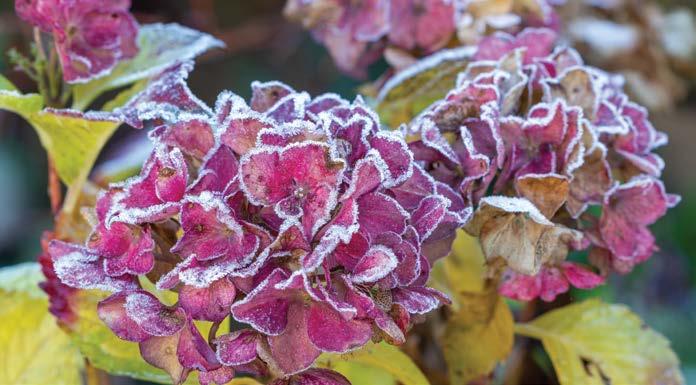
2 minute read
Growing Zones and surviving cold

How important are they?
cold, only desiccating wind. If you have plants in pots, bury them in the ground so the roots can experience a proper winter.
I love hearing from you: caharlos@ verizon.net FY
Several readers have asked about the usefulness of Growing Zones and how they relate to plants surviving cold weather. This column is for them and you!
All plants have needs that contribute to success or failure in a certain environment. In Western New York state, if you spit an orange seed in your yard, the seed may germinate but you have no expectation that it will grow into a tree in our climate.
Developed by the U.S. Department of Agriculture, Growing Zones are a set of numeric designations that assess hardiness based on the average annual lowest night temperature; the lower the Zone number, the colder the average night temp. Each zone varies by ten degrees and there are thirteen total that range from negative sixty degrees to seventy degrees Fahrenheit. Each Zone is further divided into a and b zones in five-degree variables so, for example, Zone 6a is five degrees cooler than Zone 6b. Western New York ranges from 4b to 6a.
Plant labels provide a hardiness zone range. While it is tempting to purchase plants that are hardy in higher range zones, we need to remember the difficulty of providing that higher temperature in our gardens. But we try—most of our houseplants are tropical!
Hardiness zones have limitations. Macrophylla hydrangeas are hardy down to Zone 4. This means the roots survive but the flower buds from the previous autumn can freeze. In other words, the plants live; the flowers don’t. Phlox stolonifera is hardy in Zones 4 through 8. It lives in the cold but grows slowly and never reaches its potential. Provenance also enters into this. Red bud trees purchased in northern climates may have been started from seed grown in Zone 8! This is why people are often disappointed in trees or plants that don’t succeed where they live.
You may have viewed All American Selections display gardens near the Buffalo Waterfront. Plants grown there are newly developed and being tested for hardiness, flower production, and disease resistance. Display gardens are grown in different Zones with different growing conditions in various states.
Growing Zones are not the complete answer to plant survival. Moss campion and pygmy buttercups grow and survive in the Arctic, and we know that some plants survive not only in extreme conditions but also in certain areas of our own gardens. Herbaceous plants that have no woody stems above ground die back in the autumn; their underground roots are protected by fallen leaves and other plant parts.
(How sad it is to see naked soil created by fastidious gardeners in the autumn and leaving roots unprotected!) Woody plants gradually harden off in the autumn. Green growth tissue hardens. This protects the plants from water loss, which is why you shouldn’t cut your roses back too soon; cutting back in early autumn stimulates new green growth that subsequently dies back when the season gets cold.
If you check your perennial gardens in winter, you may notice that though the top of the soil is frozen, but soil a few inches down is warmer than you would have thought. If you mulch, or let nature mulch, you’ll find the soil relatively warm.
What about snow? I remember my mother saying that a winter without snow would be a plant killer. Fresh fluffy snow is approximately ninety-five percent air and makes a great insulator. Snow also slows down evaporation of plant water by wind.
What can the gardener do to insure plant success over winter? Buy plants suitable for the Zone in which you live. Keep gardens watered until late in the season. Remember that roots grow where water is. Know that wrapping trees does not protect plants from the
Carol Ann Harlos is an awardwinning retired math and science teacher, Master Gardener, beekeeper, writer, and speaker. She tends extensive gardens, including herbs, and loves learning from others and sharing her knowledge.








